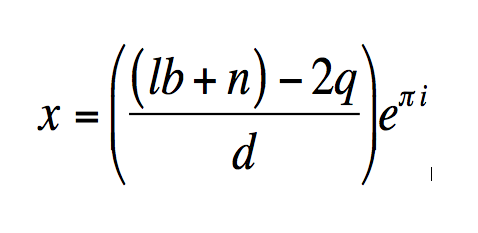Why We Shouldn’t Save Everything
February 6, 2013
Several years ago I created an equation that calculated the advancement of a society in relation to its acquisition of archived knowledge. A positive result meant the culture was advancing, a negative that it was declining.
Where lb=Weight of Cultural Burden, n=Cultural Impact, q=Quantity, & d=Amount of Existing Detritus
I’ll take a slight pause for the audience laughter to die down. But for you non-maths-nerds out there, the gimmick was that eπ i = -1, thus the outcome of the equation would always be 0 (stasis) or a negative number (decline), primarily because the production of detritus in the culture always greatly outweighs the production of standout cultural works.
Yes, I have always been this much of a punk ass fool.
Regardless, I do believe that, though my expression may be flawed (even if it made me giggle) it holds a grain of truth. Most things are not great. Most things are not even good. This does not mean that the non-great do not deserve to be saved — each collection has its own mission and reasoning — but it does infer that, of the masses and masses of content we create, there is a steep curve measuring usefulness. This usefulness may be predicated on quality, content, source, methodology, or some other factor that makes the content valuable, representative, tangential, or research-worthy. The degree, scope, and reach of these factors vary, as does the amount of importance we place on each factor personally, locally, institutionally, and beyond.
In other words, one man’s trash….
This is really nothing new (as the use of a hoary adage suggests). Prioritization and deaccessioning are part and parcel of the archival practice. More highly valued materials receive more attention and more resources. Lower value materials receive less attention and, in some cases, are/should be discarded.
Not everything can be saved. Nor should it. Not just when judged at a valuation level, but at a level of content and institutional use.
However, because we are aware of mass losses of records of the past, we are hyper-aware (and in some cases hyper-vigilant) about losing anything in the present, about letting one film frame or slip of paper evade our acid free grasps. This extremism is wrong, because it causes fear and paralysis, or, alternately, overreaction. We can become so afraid of making a mistake in our preservation choices that we freeze up, or we can’t see beyond the cost and resources needed for an entire collection to see where we can take smaller bites, or we waste resources on inessential materials and activities at the detriment of other ones. No collections benefit as much as they could in these scenarios.
One issue I see here is the undue influence of the concept of author and manuscript, especially when it comes to audiovisual archives. In an author’s or individual’s archive there is an aura projected onto the materials — everything they touched or every revision made matters.
In an archive of easily reproducible materials there is bound to be duplication, low quality viewing copies, transfers that have no meaning beyond their role in moving from platform to platform within a production process, and content that is low/poor quality but never discarded by the creator.
(And to be honest, I personally feel that the totemic aura of the object is grossly misplaced in most cases, whether the item in question is reproducible or not.)
The question we need to look at is what role the asset plays/played in the day-to-day activity of the collection. In the case of an individual author, versions or revisions may be of value in tracking the creative process. In a production environment, versioning or dubs or rough cuts may (and do) lack such value. The review copies and rough edits that cycle around a production environment are of practical, of-the-moment value but do not necessarily mean anything to the work process — the same way multiple copies of a manuscript distributed to colleagues do not reflect unique content (unless annotated).
But really, even if that is the case, we have to ask ourselves how much is enough? We don’t know what a researcher 100 years from now will be interested in, but does that matter? What is the value of that research point versus the cost of storage and preservation? The archivist’s job, in part, is to support researchers, but also to care for the collection. Does that footnote in a maybe future dissertation warrant an investment that subtracts from the ability to provide broader care?
It may seem like it does because long-term, day-to-day collection management has no wow factor, no direct feedback, and can be difficult to communicate the value of to administrators. The researcher finding one thing, exclaiming Eureka, and expressing gratitude provides that warm, energizing feeling that one’s work has been done. It is a silver dollar found in the middle of a reseeded forest. Something to spend now instead of realizing an expansive value later.
What this issue often comes down to is making a decision for which we cannot see the long-term outcome. Short-term we can assess the potential benefits, but the risk that we were wrong often prompts inaction. Realistically, though, in the long-term our inaction is a much greater burden than any action we take. At some point in the future the burden of too many assets, or undocumented assets, of half-cared for assets, or un-reformatted assets will have to be dealt with. And at that point the costs will be greater and the options will be fewer. That is not what we should be saving for the future.
— Joshua Ranger
